
Russo-Chinese Exercises in the Mediterranean
Publication: Eurasia Daily Monitor Volume: 12 Issue: 98
By:

Sino-Russian joint naval maneuvers are not a new phenomenon; they have occurred at least twice in the Far East. But the most recent maneuvers that took place in the Mediterranean, and concluded on May 21, represent some new aspects of the Russo-Chinese relationship and both sides’ policies in the Middle East (Sputnik News, May 17; TASS, May 21).
According to Russian President Vladimir Putin, these exercises—named Naval Cooperation–2015—attest to the fact that bilateral relations are at an all-time high (Interfax, May 8). Russian sources claimed the purpose of these exercises was to strengthen mutual understanding between the Russian and Chinese navies regarding “boosting stability [and] countering new challenges at sea” (RT, May 17). But three more tangible reasons exist for these sea drills in the Mediterranean. First of all, these exercises allowed both sides to signal their arrival on the international scene to all potential maritime competitors. That Russia is interested in projecting naval power into the Mediterranean is hardly news: it began trying as early as the 18th century and, with few interruptions, has continued to do so until the present day (see EDM, March 7, 2013; July 17, 2013; February 25, 2015). Indeed, this strategy is clearly connected to Russia’s eternal quest to earn international recognition for being a great power that everyone must reckon with.
A second practical point is that these exercises allowed the Chinese and Russian naval forces to increase their mutual interoperability, which can only be accomplished by exercising together and becoming familiar with each other’s equipment, routines and personnel. Third, in the past, Russia has used these occasions for joint training as opportunities to showcase naval or other weapons that it wanted to sell to China or that China was interested in acquiring. Now, the shoe is on the other foot, as China wants to sell its Type 054A frigate to Russia. Russian experts observe that the Type 054A can substitute for the obsolete vessels currently in service before the Russian Navy is able to deploy more advanced domestic-made frigates. This is because so many Chinese ships were derived form Russian and Soviet models; thus, they would be relatively compatible with Russia’s naval procedures and existing equipment. But that process, nevertheless, mandates a familiarization of the Russian Navy with these Chinese ships through such exercises (Wantchinatimes.com, May 3).
All these are compelling reasons to hold joint drills. But as US naval commentator James Holmes observed, Moscow and Beijing deliberately chose a provocative setting for Naval Cooperation–2015 (Foreign Policy, May 15). So why in the Mediterranean? The answer to this question is simple: Both Russia and China want to challenge the heretofore uncontested primacy of the West and especially the United States in the Middle East. And an available and useful way to do so is to demonstrate not only the capacity to project power into the Middle East via naval maneuvers in waters west of the Levant, but also to sustain it. In China’s case, it has had to conduct several noncombatant evacuation operations (NEO) from the region since 2011—including evacuating by sea hundreds of its nationals from Yemen this past April (Xinhua, April 6). Furthermore, Beijing has now made clear it is a rising power with growing interests in the entire Middle East and Africa, and it seeks a base in Djibouti, on the Horn of Africa (Xinhua, May 26; Defense News, May 16). These aspirations testify to Beijing’s increasing naval strength and a desire to project it to defend Chinese interests far from its territory and coast.
All these are compelling motives for Russo-Chinese exercises in general and for operating in the Mediterranean in particular, but there is one last important factor to note here. More and more, Russia can be seen trying to associate China with Moscow’s Middle Eastern initiatives—for example, in Yemen and Iran. On the one hand, these are undoubtedly attempts to show solidarity and constrain Western and US options throughout the volatile Middle East. But arguably, one can also observe a different motive, one equally consistent with the broader conduct of Russian foreign policy.
Increasingly, it appears that Russia senses it cannot leverage its goals in the Middle East vis-à-vis the US unless it induces China to associate itself with them. On that basis, Russia can borrow from China’s burgeoning power to make a powerful impression on the United States and on the Middle Eastern governments. This stratagem conforms to Moscow’s larger global agenda of identifying ever more with Beijing in an effort to force Washington to take Russia more seriously than had been the case until now.
Given the ideological-political harmony or convergence between Moscow and Beijing, it is not difficult to make this connection against Washington. But at the end of the day, this Russian policy and related trends—not least having to depend on China to sell it frigates to rescue Russia’s ailing naval program—demonstrates, even unintentionally, that Russia is a declining power that increasingly depends on China for its status and influence. Indeed, China alone gains from this policy, and given the reverses suffered by Syrian President Bashar al-Assad lately, it is not clear just how much Russia actually benefits from its policy approach.
But apparently, Russia’s anti-Americanism is now so strong that it seems willing—for the foreseeable future, if not beyond—to play second fiddle to China in the alliance or partnership between them. Russia is growing ever more assertive or aggressive in both the Middle East and Europe. But in the Middle East, at least, China seems intent and increasingly able to become not only the leading partner in the Moscow-Beijing relationship, but also the sole beneficiary of Russia’s own regional policy.




